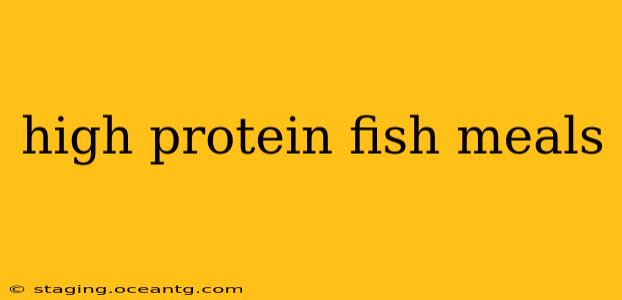Fish is a fantastic source of lean protein, offering numerous health benefits. Including high-protein fish meals in your diet can contribute to muscle growth, weight management, and overall well-being. This comprehensive guide explores various high-protein fish options, provides recipe ideas, and answers common questions about incorporating more fish into your diet.
What are some of the highest protein fish?
Many fish are excellent sources of protein, but some stand out for their particularly high protein content. Generally, the larger, more oily fish tend to be higher in protein. Top contenders include:
- Salmon: A powerhouse of protein and omega-3 fatty acids. A 3-ounce serving can provide around 20-25 grams of protein.
- Tuna: Another popular choice, readily available canned or fresh. Similar to salmon in protein content, with a 3-ounce serving offering about 20-30 grams of protein, depending on the type.
- Cod: A leaner white fish, cod is a good source of protein with a slightly milder flavor. A 3-ounce serving provides approximately 18-20 grams of protein.
- Tilapia: A relatively inexpensive and widely available fish, tilapia offers around 20 grams of protein per 3-ounce serving.
- Halibut: This firm, flaky white fish is rich in protein, with a 3-ounce serving containing roughly 20-25 grams.
How much protein is in a 3-ounce serving of fish?
The exact protein content in a 3-ounce serving of fish varies depending on the species and preparation method. However, as outlined above, many popular high-protein fish varieties typically contain between 18-30 grams of protein per 3-ounce serving. It's always best to check nutrition labels for the most accurate information.
What are some easy high-protein fish recipes?
The beauty of fish is its versatility. It can be grilled, baked, pan-fried, or even added to salads and soups. Here are a few easy recipe ideas:
1. Grilled Salmon with Asparagus: Marinate salmon fillets in a mixture of olive oil, lemon juice, garlic, and herbs. Grill until cooked through, and serve with grilled asparagus for a complete and healthy meal.
2. Baked Cod with Lemon and Dill: Bake cod fillets seasoned with lemon juice, dill, salt, and pepper until flaky. This simple recipe is quick, easy, and delicious.
3. Tuna Salad Lettuce Wraps: Mix canned tuna with Greek yogurt, celery, red onion, and seasonings. Serve in lettuce cups for a low-carb, high-protein meal.
4. Tilapia with Roasted Vegetables: Season tilapia fillets and bake alongside your favorite roasted vegetables like broccoli, carrots, and bell peppers.
Is it better to eat fish or chicken for protein?
Both fish and chicken are excellent sources of protein. However, fish often boasts a higher concentration of omega-3 fatty acids, which are essential for heart health and brain function. Chicken tends to be a bit higher in saturated fat. The best choice depends on individual dietary needs and preferences. A balanced diet incorporating both can be beneficial.
Are there any health risks associated with eating too much fish?
While fish is incredibly healthy, consuming excessive amounts can present some potential risks. Some fish contain high levels of mercury, which can be harmful in large quantities. Pregnant women and young children should be especially mindful of mercury levels and choose lower-mercury options. Always refer to official guidelines for safe fish consumption. Additionally, individuals with seafood allergies must exercise caution.
What are some good substitutes for high-protein fish?
If you don't eat fish, there are many other excellent high-protein options:
- Chicken breast: Lean and readily available.
- Turkey breast: Another lean poultry option.
- Lean beef: Choose cuts with lower fat content.
- Eggs: A versatile and affordable protein source.
- Legumes: Beans and lentils are packed with protein and fiber.
By incorporating high-protein fish meals into your diet, you can enjoy a delicious and nutritious way to boost your protein intake and support your overall health. Remember to choose a variety of fish and be mindful of portion sizes and potential health concerns.
